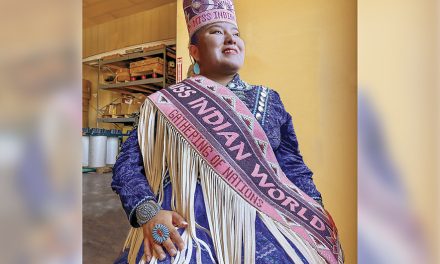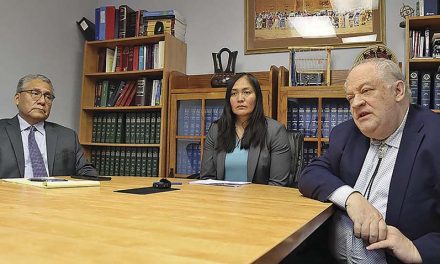
Syphilis on the rise in Arizona
WINDOW ROCK
With the surge of sexually transmitted disease cases in Arizona, the Arizona Department of Health Services reveals syphilis is surging and is worrisome for Native American/Alaska Natives, who make up about 6 percent of the population but account for nearly 14 percent of syphilis cases in the state.
Syphilis is one of many STDs that, if left untreated, can cause neurological problems like dementia, lead to blindness, and attack other organs in the body.
Since 2015 to August, the yearly average of syphilis cases in women and babies has increased by nearly 450 percent. When left undetected and untreated, up to 40 percent of congenital cases result in stillbirth or newborn death because of inadequate treatment.
Congenital syphilis is when a mother with syphilis passes the infection to her baby during pregnancy and can cause harm by miscarriage, stillbirth, and infant death.
Babies who survive can have irreversible damage to the skin, bones, joints, eyes, ears, and brain, ADHS reveals.
Although congenital syphilis is high, the surge of syphilis cases concerns healthcare providers and educators, and they strongly encourage everyone to get tested.
Curable with penicillin
Syphilis is curable with penicillin.
However, in April, the U.S. Food and Drug Administration announced a shortage of the preferred antibiotic.
The antibiotic is in high demand, and its limited access is expected to last until 2024, Cheryl Cook, an HIV health educator with the Navajo Health Education Program in Tuba City, confirmed.
Cook, a passionate advocate for sexual health education, encourages individuals to get tested annually for syphilis. She mainly urges yearly testing because most people do not know they are infected.
Syphilis often shows no symptoms until it is too late.
Blood tests, not urine tests, are used to confirm syphilis infections.
Syphilis occurs only with direct contact with an infected individual during vaginal, anal, or oral sex. It cannot be contracted by casual contact with things like toilet seats, bathtubs, shared clothes, eating utensils, doorknobs, and so forth.
Signs, symptoms, and treatment
Shandiin Begay, Canyonlands Healthcare’s family planning director in Page, Arizona, has worked in the field for over eight years.
“It is important to provide these services to the Navajo Nation,” said Begay. Canyonlands Healthcare has clinics throughout Arizona, including Chilchinbeto.
The clinic provides family planning resources like birth control, Plan B, STD testing and treatment, and other primary care services.
The clinic also has an in-house pharmacy so patients can receive treatment and other medications on-site.
And in Arizona, teens may use these services, Begay stressed, without the presence of a parent or guardian.
Begay outlined the different stages of syphilis, primary and secondary, and what to look out for in each.
Primary symptoms include painless sores in the mouth and genital area that can spread the infection to a partner or partners.
Secondary symptoms include sores, body rash on hands and feet, flu-like symptoms, and patchy hair loss.
Primary and secondary symptoms are treatable within the first 12 months of infection with one dose of antibiotics. A person with the disease for one or more years requires at least three doses of antibiotics at one-week intervals. “With syphilis, it is not good for infants,” said Begay, “so it is very important for pregnant mothers to seek prenatal care early.”
Begay’s work is funded by a federal grant called Title X, which allows individuals of reproductive age to receive desired services in their clinics using public or private insurance.
The program also allows the clinic to provide services using a sliding fee for those without insurance or patients who do not want STI testing, or treatment reported on their parent’s or partner’s insurance. Depending on the patient’s household size and income, the cost could range from zero to 60 dollars for those who qualify.
Patients seeking extra privacy for STI-related visits can request a confidential or “penny lane visit” upon arrival.
These services complement the care provided by local Indian Health Services service units and act as an additional resource to expand STI testing and treatment in the Nation.
Prevention
Cook outlines that the number of cases can be reduced if people use protection, talk to a doctor openly about their sexual health, talk to their partners, seek testing, and follow up for positive cases.
Fortunately, the program Cook is a part of has been receiving help from the Arizona Department of Public Health to order condoms, which she can supply for free to health care facilities like Tuba City Regional Health Care Corporation and gas stations across Western Agency.
People should be able to find free condoms at gas stations in Cameron, Gray Mountain, Tuba City, and Toadlena.
“That’s the only way to avoid STIs,” Cook said, besides abstinence.
Talk openly about sexual health
Since moving to Tuba City nine years ago, Cook has visited schools and conferences informing the public about the importance of preventing syphilis, other STDs, and HIV.
Cook believes the topic should not be taboo and stresses the importance of having open conversations about sex education, regardless of age and gender.
Discussing sexual health in schools is one way to educate students who do not have access to information because no one talks about it.
“People can have multiple STIs,” Cook said. “We (see) people who had gonorrhea, chlamydia, and syphilis, all at the same time, even have HIV.”
According to ADHS, the number of STDs for 15–19-year-olds combined is 6,867. This number is high for 15–19-year-olds, of which 82 are syphilis cases this year.
This indicates teenagers are sexually active, and some are not given the information and resources to be safe.
The age group with the highest number of syphilis cases is 30–34-year-olds, which has roughly 482 cases this year, ADHS reveals.
On occasion, Cook encounters patients who decline testing because they associate a stigma with having an STD. They believe they are healthy or would prefer not to know their status.
With the continuing rates, some goals Cook shared include introducing more education at Navajo schools, workplaces, communities, and potentially to the Navajo Nation Council delegates.








 Highway 264,
Highway 264, I-40, WB @ Winslow
I-40, WB @ Winslow